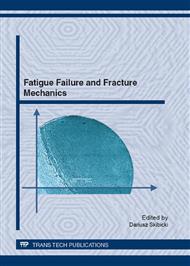p.69
p.77
p.84
p.93
p.100
p.106
p.110
p.118
p.125
Influence of the Notch Rounding Radius on Estimating the Elastic Notch Stress Concentration Factor in a Laser Welded Tee Joint
Abstract:
In recent years an increased interest of industry in sandwich-type metal structures can be observed. These structures consist of thin plates of 2.5 mm in thickness separated by stiffeners of different shapes and forms. Welds joining the plates and stiffeners are made on the outer side of the plates using laser welding technique. A locally focused source of heat causes the plate to melt creating a very narrow and elongated joint. As a result, sharp geometric notches are formed on the side of the root of a weld – a place which is inaccessible and cannot be checked. Geometries of individual welded joints vary, sometimes considerably, and this makes their analysis even more complicated. Additionally, the use of laser welding technique influences the formation of untypical distribution of changes in material properties in weld zones. The effect is a joint whose behaviour under load is significantly different from the behaviour of a welded tee joint made with the use of classical methods. Fatigue strength calculations for this type of joints can be conducted based on local stress values in notches, which can be determined with the use of Finite Element Method (FEM). This article analyses the influence of the notch rounding radius on the elastic notch stress concentration factor Kt The aim of the analysis is to evaluate the notch stress concentration according to local notch stress approach.
Info:
Periodical:
Pages:
100-105
Citation:
Online since:
August 2012
Authors:
Price:
Сopyright:
© 2012 Trans Tech Publications Ltd. All Rights Reserved
Share:
Citation:


